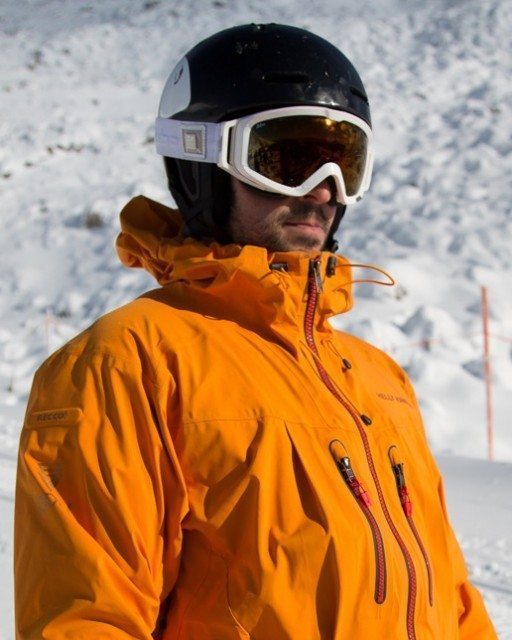Weight
At 450 grams (claimed weight), the Fornix Backcountry MIPS is light. By comparison, the new Smith Vantage comes in at 479 grams (Blister verified) and I honestly couldn’t notice the 29-gram weight difference.

MIPS
Finally, the MIPS system. MIPS, or Multi-directional Impact Protection System, is a Swedish technology developed and patented by researchers in biomechanics and neuroscience at the Royal Institute of Technology and the Karolinska Institute.
The reasoning behind it is quite simple, but I haven’t verified it in the field (read: crashed), so my real-world experience is nil. But think about how you fall in an accident, be it skiing or mountain biking. You’re usually moving forward, and when your head hits the ground, it usually hits at an oblique (not vertical) angle. This transfers a rotational force to your skull and ultimately to your brain. For years, helmets were typically tested using a vertical fall where the theoretical helmet wearer would suffer a straight-to-the-top-of-the-dome impact, which is pretty unlikely in most sports.
Knowing this, researchers looked at how the skull protects the brain from this type of impact. Turns out, the brain is surrounded by a low-friction cushion of cerebrospinal fluid that can rotate when the skull takes an impact. Forces are dispersed not by crumpling but by rotation. Think of it like Jackie Chan doing a full roll when he jumps from a higher rooftop to a lower one, instead of landing square (and breaking his legs).
Inside the three-piece outer shell of Aramid-reinforced EPS and PV there is a thin yellow plastic liner anchored to the shell at two points using small plastic tabs. This essentially creates a liner that can easily allow the outer shell to rotate one way, while cradling the head and allowing it to stay at rest during an impact. MIPS claims that this system reduces the chance of serious head injury by up to 40%.

In the above image you can see a conceptual MIPS-equipped helmet with the outer shell and the low-friction layer covering the liner. In the POC Fornix Backcountry MIPS helmet, the MIPS layer and padding sit directly around the wearer’s head.
POC guarantees that they will replace the MIPS liner after a fall serious enough to tear one away. But at that point your helmet is likely done for, and it’s probably wise to retire any helmet that’s taken a big enough impact to concuss you.
For more information about this technology, visit the MIPS website.
Bottom Line
The POC Fornix Backcountry MIPS is comfortable and light, and it has the MIPS system which may provide some extra protection in an oblique, rotating fall.
I know many skiers who don’t use their vents, and for them, the Fornix would be perfectly fine. But I adjust my vents all the time since I get hot easily, and I’d like to see POC refine the venting of the Fornix.

I’m slightly skeptical about the usefulness of MIPS in ski helmets… it seems most useful in a fall onto high-friction surfaces (say, asphalt) which are more likely to ‘grab’ the shell of the helmet and apply those brain-shearing forces. On a low-friction surface like most kinds of snow, that’s much less likely to happen, no? Useful for a bike helmet, but the Fornix isn’t certified for that…
On slippery surfaces is good enough almost any helmet. The problem is that fatal accidents or serious consequences accidents does not happen on slippery surfaces but from the impact of with hard, static objects (trees, for example). MIPS tries to solve this type of accidents…
Hi Ru and dana,
Ru: what you say is true, to some extent. Asphalt does have a higher coefficient of friction than snow. There are other forces at play to consider, though. One is that generally speeds involved in skiing are higher than in biking (almost certainly than in mountain biking, and generally higher than road biking, barring long, steep descents). So the force imparted to the skull in a deceleration from a higher speed will be higher. MIPS hopes to help with that braking force by allowing more rotation than a normal helmet. Also dand brings up another good point in that it’s not always the snow surface that is of concern – it can be rocks and trees. I ski the East now, and tree skiing is our bread and butter. If I hit my head on a tree after falling, I’d like to think that my helmet will be able to hit that higher-friction surface and rotate somewhat, giving me a better chance of not getting a concussion.
Additionally POC, among other manufacturers, are making MIPS bike helmets. I’ve been using the POC Trabec Race MIPS helmet all summer. It’s a nice bike helmet and incorporates MIPS, which is important to me. As far as I’m concerned, the biggest argument against MIPS currently is the price penalty one has to pay for the technology. It doesn’t weigh much (20 grams claimed, though I haven’t taken it out of a helmet to weight it independently) and doesn’t add any bulk to the helmet (it’s a thin plastic slip layer). So if you can afford it, it could be worth it.
dana
I think Michael Schumacher’s recent fall and current condition may help elevate people’s opinions of the importance of MIPS. Lacerations are way down, but rotational TBI has not dropped with the widespread adoption of helmets in skiing.
I tried to remove the ear pads, but it seems that they are nondetachable. Is there anybody having the same issue?
Hi Winston, could you please tell if the ear pads can be opened and is it possible to put a headphone system in them?
Thanks!